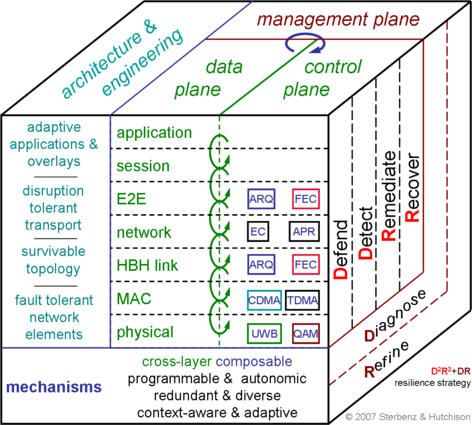ResiliNets Architecture
Contents |
Definitions
Definitions and terminology that provide the foundation for the ResiliNets Architecture
ResiliNets Axioms, Strategy, and Principles
ResiliNets Axioms
IUER: inevitable, understand, expect, respond
A0. Inevitability of Faults
A1. Understand Normal Operations
A2. Expect Adverse Events and Conditions
A3. Respond to the Adverse Events and Conditions
ResiliNets Strategy
D2R2+DR: defend, detect, remediate, recover, diagnose, refine
S1. Defend
S2. Detect
S3. Remediate
S4. Recover
S5. Diagnose
S6. Refine
ResiliNets Principles
Principle Relationships Spreadsheet
Prerequisites
P1. Service Requirements determine the need for network resilience
P2. Normal Behaviour must be specified, verified, and refined through monitoring to understand normal operations
P3. Threat and Challenge Models are essential to understanding and detecting potential adverse events and conditions
P4. Metrics are needed to measure and engineer network resilience
P5. Heterogeneity in mechanism, trust, and policy among different network realms is a reality of emerging multi-provider networks; resilient mechanisms must admit this heterogeneity.
Tradeoffs
P6. Resource Tradeoffs determine the deployment of resilience mechanisms
P7. Complexity of the network in general, and resilience in particular, must be reduced to maximise overall resilience
P8. State Management is an essential aspect of networks in general, and resilience mechanisms in particular; the alternatives of how to distribute and manage this state are critical to resilience
Enablers
P9. Security and Self-Protection is an essential property of entities to defend against challenges in a resilient network
P10. Connectivity and Association among communicating entities should be maintained when possible, but information flow should still take place even when a stable end-to-end path does not exit
P11. Redundancy in space and time increases resilience against faults and some challenges
P12. Diversity in space, time, medium, and mechanism increases resilience against challenges to particular choices
P13. Multilevel Resilience is needed with respect to protocol layer, protocol plane, and hierarchical network organisation
P14. Context Awareness is necessary for network components to operate autonomously to detect challenges
P15. Translucency is needed to control the degree of abstraction vs. the visibility between levels
Behaviour
P16. Self-Organising and Autonomic behaviour is necessary for network resilience that is highly reactive with minimal human intervention
P17. Adaptability to the network environment is essential for a node in a resilient network to detect, remediate, and recover from challenges
P18. Evolvability is needed to refine future behaviour to improve the response to challenges, as well as for the network architecture and protocols to respond to emerging threats and application demands
Challenges and Failures
- Challenges
- Service Description
- Resilinets Failure Classes (to be replaced by Failure Classification somewhen in the future)
Scenarios
ResiliNets Mechanisms
Publications
James P.G. Sterbenz, Egemen K. Çetinkaya, Mahmood A. Hameed, Abdul Jabbar, and Justin P. Rohrer,
“Modelling and Analysis of Network Resilience (invited paper)”,
The Third IEEE International Conference on Communication Systems and Networks (COMSNETS),
Bangalore, India, January 2011, (to appear)
BibTeX
- Keywords: Future Internet architecture, resilience, survivability, performability, dependability, topology, population, attack, disaster, challenge, metrics, generation, simulation, modelling
- Abstract: “As the Internet becomes increasingly important to all aspects of society, the consequences of disruption become increasingly severe. Thus it is critical to increase the resilience and survivability of the future network. We define resilience as the ability of the network to provide desired service even when challenged by attacks, large-scale disasters, and other failures. This paper describes a comprehensive methodology to evaluate network resilience using a combination of analytical and simulation techniques with the goal of improving the resilience and survivability of the Future Internet.”
James P.G. Sterbenz, David Hutchison, Egemen Çetinkaya, Abdul Jabbar, Justin P. Rohrer, Marcus Schöller, Paul Smith,
“Resilience and Survivability in Communication Networks: Strategies, Principles, and Survey of Disciplines”,
Computer Networks: Special Issue on Resilient and Survivable Networks (COMNET),
vol.54 iss.8, June 2010, pp.1245–1265
BibTeX
- Keywords: communication network and Future Internet resilience, fault tolerance, survivability, disruption tolerance, dependability, reliability, availability, security, performability, critical infrastructure, defence, defense, detection, remediation, recovery, restoration, diagnosis, refinement, metrics
- Abstract: “The Internet has become essential to all aspects of modern life, and thus the consequences of network disruption have become increasingly severe. It is widely recognised that the Internet is not sufficiently resilient, survivable, and dependable, and that significant research, development, and engineering is necessary to improve the situation. This paper provides an architectural framework for resilience and survivability in communication networks and provides a survey of the disciplines that resilience encompasses, along with significant past failures of the network infrastructure. A resilience strategy is presented to defend against, detect, and remediate challenges, a set of principles for designing resilient networks is presented, and techniques are described to analyse network resilience.”
Related Projects
Postmodern Internetwork Architecture
People
© 2006–2007 James P.G. Sterbenz and David Hutchison

